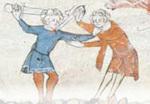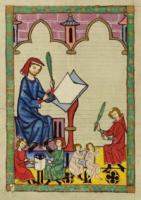Medieval Student Violence
Scott Jenkins / Swansea University
Source - http://www.medievalists.net/2011/11/22/medieval-student-violence/
 Throughout the middle ages university towns such as Oxford, Paris and Bologna were incredibly dangerous places to live. Medieval students, it seems, often engaged in violent clashes with the townsmen and with one another. My PhD research is a comparative analysis of medieval student crime and violence in Oxford and Bologna during the fourteenth century. Frequently in both contemporary source material and secondary literature student violence is portrayed as the actions of a drunken, violent minority who, as a result of clerical privileges bestowed upon students, did not fear temporal justice. Through my research I highlight why this negative stereotyping does not aid us in the study of violence and criminality, or medieval student life, and attempt to return some sense of agency to the medieval student hitherto denied by the historiography. It is my contention that this student violence can be broadly categorised in three ways. The first is the violence between the town and gown, the second the violence between nations, and lastly, the interpersonal violence between individuals. Often there are overlaps between these categories and there are, as one would expect, large differences between the two towns I am studying.
Throughout the middle ages university towns such as Oxford, Paris and Bologna were incredibly dangerous places to live. Medieval students, it seems, often engaged in violent clashes with the townsmen and with one another. My PhD research is a comparative analysis of medieval student crime and violence in Oxford and Bologna during the fourteenth century. Frequently in both contemporary source material and secondary literature student violence is portrayed as the actions of a drunken, violent minority who, as a result of clerical privileges bestowed upon students, did not fear temporal justice. Through my research I highlight why this negative stereotyping does not aid us in the study of violence and criminality, or medieval student life, and attempt to return some sense of agency to the medieval student hitherto denied by the historiography. It is my contention that this student violence can be broadly categorised in three ways. The first is the violence between the town and gown, the second the violence between nations, and lastly, the interpersonal violence between individuals. Often there are overlaps between these categories and there are, as one would expect, large differences between the two towns I am studying.

The clashes between the townspeople and the scholars of medieval universities were a frequent occurrence in Oxford and Bologna. During the middle ages the universities as corporations engaged in conflict with the towns they inhabited and their governing bodies over jurisdiction and space. The English Close Rolls are replete with evidence of the complaints from both the Chancellor and the Mayor that Oxford was not properly governed, and that the problem would be settled by more, or less, power given to the Chancellor of Oxford’s university. In Bologna, such jurisdictional problems were given an added dimension to the university scholars being seen as natural allies to the noble, or Ghibilline, party. The high point in the conflict between the Guelph and Ghibelline factions in Bologna was in 1274 with the expulsion of the Lambertazzi family and their supporters, with the university coming under attack in the process. The use of space in both towns was also contested by the universities with pressure exerted on external authorities to control where animals were slaughtered and where prostitutes plied their trade in order to prevent scholars from being distracted from their studies.
The second type of violence identified within my research is that of inter-community conflict conducted by the ‘nations’. These ‘nations’ had little to do with the modern understanding of the term, and instead were fraternal associations of scholars drawn from similar regions. These nations mirror and reflect the geo-political affiliations and conflicts important to their membership. So, for example, the nations in Bologna changed shape and identity in accordance with the evolution of territorial disputes in their homelands, one such changed occurring between 1265 and 1432 the French nation’s ‘catchment’ area had been redrawn to include the duchy of Normandy.[1] The nations in Bologna elected the Rector of the university, and the conflicts which occurred between the nations tended to revolve around disputed elections or struggles for hegemony. Contrast this with Oxford where there were only two nations, the Australes representing the south of England, and the Boreales representing the North. The southern nation, as we might expect was the more powerful of the two nations, and despite the peripheral nature of the Celtic Fringe in the middle ages the ‘Welsh’ were considered part of the southern nation. The nations, in the beginning at least, each elected one of the universities two Proctors but this practice was abolished, along with the nations in 1275 after frequent violent clashes between them. The truce which resulted ‘resembled those between hostile armies’.[2] The tension between the nations in Oxford was not so vulnerable to legislation and conflict continued well into the sixteenth century (at least, this is as far as I have read). Nor was this violence merely the action of drunken goliardic students destined for a life of obscurity. Robert de Aylington, a reputed theologian and opponent of Wycliffe, and who would later become Chancellor of the university, was indicted for an attack on Welsh scholars in 1388.[3] The chronicler Adam of Usk recalled his taking part in a violent clash between northern scholars and the Welsh in Oxford in the latter part of the fourteenth century.[4] These near continuous violent clashes represent the conflict between particularist identities in medieval Oxford and the struggle for the balance of power within the university.

The interpersonal violence committed between individual and small groups of scholars follows closely the trends identified above, in that conflicts are reported between groups of students of different nations and between students and townspeople. They also show that scholars in Oxford have a tendency to commit more violent criminal acts, and to focus on high risk/reward crimes which is in keeping with what Barbara Hanawalt observed of clerical criminality elsewhere in England.[5] In Bologna conflicts between individual members of rival nations seem to predominate. While both scholars in Oxford and Bologna are certainly visible, they do not appear in the numbers that would suggest confirmation of the negative stereotype of the drunk and violent scholar. Individual violence and criminality can in many cases be associated with corporate tensions, such as town and gown disputes in Oxford, or the power struggles between the nations in Oxford and Bologna.
This is not to give the impression that our picture of the medieval student is necessarily wrong, there are certainly appalling acts of violence, large scale pitched battles and numerous incidents of robbery, housebreaking and homicide. Scholars did, despite castigation, frequent taverns and brothels and judging from the literary evidence, play vicious pranks on their elders and superiors. From my study I cannot deny that these students existed, but that the polar extremes of the true and false scholar are literary tropes conjured by moralistic authors and unhelpful in the study of student crime and violence much of which was motivated by tensions between conflicting polities, corporations or regional identities.
1 The seminal work on the history and function of the Nations is Pearl Kibre’s brilliant The Nations in Medieval Universities published by the Medieval Academy of America in 1948. The changes to the French nation can be found in Statuti delle univiversita e dei collegi dello studio Bolognese edited by Carlo Malagola (Bologna: N. Zanichelli, 1888) p. 68-71
2 Ibid p. 163
3 A.B Emden, Biographical Register of the University of Oxford, volume I, page 30.
4 The Chronicle of Adam of Usk edited and translated by Chris Given-Wilson (Oxford: Clarendon, 1997) p. 15.
5 Barbara Hanawalt, Crime and Conflict in English Communities. 1300-1348, p.136-7